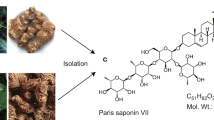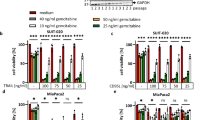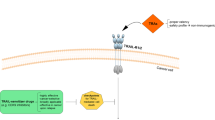Abstract
The antitumor activity of the sesquiterpene lactone parthenolide, an active ingredient of medicinal plants, is believed to be due to the inhibition of DNA binding of transcription factors NF-κB and STAT-3, reduction in MAP kinase activity and the generation of reactive oxygen. In this report, we show that parthenolide activates c-Jun N-terminal kinase (JNK), which is independent of inhibition of NF-κB DNA binding and generation of reactive oxygen species. Parthenolide reversed resistance of breast cancer cells to tumor necrosis factor-related apoptosis-inducing ligand (TRAIL)-induced apoptosis. Cancer cells treated with a combination of TRAIL and parthenolide underwent massive typical apoptosis and atypical apoptosis involving the loss of plasma membrane integrity. JNK activity is necessary for the parthenolide-induced sensitization to TRAIL because a dominant-negative JNK or the JNK inhibitor SP600125 reduced TRAIL plus parthenolide-induced apoptosis. Parthenolide induced phosphorylation of Bid and increased TRAIL-dependent cleavage of Bid without affecting caspase 8 activities. Cytochrome c but not Smac/DIABLO was released from the mitochondria in cells treated with parthenolide alone. Parthenolide through JNK increased the TRAIL-mediated degradation of the antiapoptotic protein X-linked inhibitor of apoptosis (XIAP). Enhanced XIAP cleavage correlated with increased and prolonged caspase 3 activity and PARP cleavage, suggesting that the sensitization to TRAIL involves ‘feed forward’ activation of caspase 3. These results identify a new antitumor activity of parthenolide, which can be exploited to reverse resistance of cancer cells to TRAIL, particularly those with elevated XIAP levels.
This is a preview of subscription content, access via your institution
Access options
Subscribe to this journal
Receive 50 print issues and online access
$259.00 per year
only $5.18 per issue
Buy this article
- Purchase on SpringerLink
- Instant access to full article PDF
Prices may be subject to local taxes which are calculated during checkout








Similar content being viewed by others
Abbreviations
- TRAIL:
-
tumor necrosis factor-related apoptosis-inducing ligand
- JNK:
-
c-Jun N-terminal kinase
- PARP:
-
poly(ADP-ribose) polymerase
- Z-VAD-FMK:
-
N-tert-butoxy-carbonyl-Val-Ala-Asp-fluromethyl-ketone
- NF-κB:
-
nuclear factor kappaB
- EMSA:
-
electrophoretic mobility shift assay
- XIAP:
-
X-linked inhibitor of apoptosis protein
- Smac:
-
second mitochondria-derived activator of caspases
- MTS, (3-(4:
-
5-dimethylthiazol-2-yl)-5-(3-carboxymethoxyphenyl)-2-(4-sulfophenyl)-2H-tetrazolium
References
Baldwin AS . (2001). J. Clin. Invest., 107, 241–246.
Beg AA and Baltimore D . (1996). Science, 274, 782–784.
Berman PA and Adams PA . (1997). Free Radic. Biol. Med., 22, 1283–1288.
Bernard D, Quatannens B, Vandenbunder B and Abbadie C . (2001). J. Biol. Chem., 276, 27322–27328.
Berns EM, Foekens JA, Vossen R, Look MP, Devilee P, Henzen-Logmans SC, van Staveren IL, van Putten WL, Inganas M, Meijer-van Gelder ME, Cornelisse C, Claassen CJ, Portengen H, Bakker B and Klijn JG . (2000). Cancer Res., 60, 2155–2162.
Bhat-Nakshatri P, Newton TR, Goulet Jr R and Nakshatri H . (1998). Proc. Natl. Acad. Sci. USA, 95, 6971–6976.
Biswas DK, Cruz AP, Gansberger E and Pardee AB . (2000). Proc. Natl. Acad. Sci. USA, 97, 8542–8547.
Bratton SB and Cohen GM . (2003). Cell Death Differ., 10, 4–6.
Bykov VJ, Issaeva N, Shilov A, Hultcrantz M, Pugacheva E, Chumakov P, Bergman J, Wiman KG and Selivanova G . (2002). Nat. Med., 8, 282–288.
Chauhan D, Li G, Hideshima T, Podar K, Mitsiades C, Mitsiades N, Munshi N, Kharbanda S and Anderson KC . (2003). J. Biol. Chem., 278, 17593–17596.
Chinnaiyan AM, Prasad U, Shankar S, Hamstra DA, Shanaiah M, Chenevert TL, Ross BD and Rehemtulla A . (2000). Proc. Natl. Acad. Sci. USA, 97, 1754–1759.
Daniel PT, Wieder T, Sturm I and Schulze-Osthoff K . (2001). Leukemia, 15, 1022–1032.
Davis RJ . (2000). Cell, 103, 239–252.
De Smaele E, Zazzeroni F, Papa S, Nguyen DU, Jin R, Jones J, Cong R and Franzoso G . (2001). Nature, 414, 308–313.
Deng Y, Ren X, Yang L, Lin Y and Wu X . (2003). Cell, 115, 61–70.
Desagher S, Osen-Sand A, Montessuit S, Magnenat E, Vilbois F, Hochmann A, Journot L, Antonsson B and Martinou JC . (2001). Mol. Cell., 8, 601–611.
Deveraux QL, Leo E, Stennicke HR, Welsh K, Salvesen GS and Reed JC . (1999). EMBO J., 18, 5242–5251.
Eid MA, Lewis RW, Abdel-Mageed AB and Kumar MV . (2002). Int. J. Oncol., 21, 111–117.
Hehner SP, Heinrich M, Bork PM, Vogt M, Ratter F, Lehmann V, Schulze-Osthoff K, Dröge W and Schmitz ML . (1998). J. Biol. Chem., 273, 1288–1297.
Hehner SP, Hofmann TG, Droge W and Schmitz ML . (1999). J. Immunol., 163, 5617–5623.
Hell K, Saleh M, Crescenzo GD, O’Connor-McCourt MD and Nicholson DW . (2003). Cell Death Differ., 10, 1234–1239.
Herr I, Wilhelm D, Meyer E, Jeremias I, Angel P and Debatin KM . (1999). Cell Death Differ., 6, 130–135.
Javelaud D and Besancon F . (2001). Oncogene, 20, 4365–4372.
Johnstone RW, Ruefli AA and Lowe SW . (2002). Cell, 108, 153–164.
Karin M, Cao Y, Greten FR and Li ZW . (2002). Nat. Rev. Cancer, 2, 301–310.
Kennedy NJ and Davis RJ . (2003). Cell Cycle, 2, 199–201.
Kim EH, Kim SU, Shin DY and Choi KS . (2004). Oncogene, 23, 446–456.
Lamb JA, Ventura JJ, Hess P, Flavell RA and Davis RJ . (2003). Mol. Cell, 11, 1479–1489.
Lawrence D, Shahrokh Z, Marsters S, Achilles K, Shih D, Mounho B, Hillan K, Totpal K, DeForge L, Schow P, Hooley J, Sherwood S, Pai R, Leung S, Khan L, Gliniak B, Bussiere J, Smith CA, Strom SS, Kelley S, Fox JA, Thomas D and Ashkenazi A . (2001). Nat. Med., 7, 383–385.
LeBlanc HN and Ashkenazi A . (2003). Cell. Death Differ., 10, 66–75.
Lei K and Davis RJ . (2003). Proc. Natl. Acad. Sci. USA, 100, 2432–2437.
Lin A . (2003). Bioessays, 25, 17–24.
Luo X, Budihardjo I, Zou H, Slaughter C and Wang X . (1998). Cell, 94, 481–490.
Martins LM, Turk BE, Cowling V, Borg A, Jarrell ET, Cantley LC and Downward J . (2003). J. Biol. Chem., 278, 49417–49427.
Nakshatri H, Bhat-Nakshatri P, Martin DA, Goulet Jr RJ and Sledge Jr GW . (1997). Mol. Cell Biol., 17, 3629–3639.
Nakshatri H and Goulet Jr RJ . (2002). Curr. Probl. Cancer, 26, 282–309.
Newton TR, Patel NM, Bhat-Nakshatri P, Stauss CR, Goulet Jr RJ and Nakshatri H . (1999). J. Biol. Chem., 274, 18827–18835.
Ng CP, Zisman A and Bonavida B . (2002). Prostate, 53, 286–299.
Nicholson RI, Hutcheson IR, Harper ME, Knowlden JM, Barrow D, McClelland RA, Jones HE, Wakeling AE and Gee JM . (2001). Endocr. Relat. Cancer, 8, 175–182.
Nozaki S, Sledge Jr GW and Nakshatri H . (2000). Biochem. Biophys. Res. Commun., 275, 60–62.
Ozoren N and El-Deiry WS . (2003). Semin. Cancer Biol., 13, 135–147.
Patel NM, Nozaki S, Shortle NH, Bhat-Nakshatri P, Newton TR, Rice S, Gelfanov V, Boswell SH, Goulet Jr RJ, Sledge Jr GW and Nakshatri H . (2000). Oncogene, 19, 4159–4169.
Pearson G, Robinson F, Beers Gibson T, Xu BE, Karandikar M, Berman K and Cobb MH . (2001). Endocr. Rev., 22, 153–183.
Pozarowski P, Halicka DH and Darzynkiewicz Z . (2003a). Cell Cycle, 2, 377–383.
Pozarowski P, Halicka DH and Darzynkiewicz Z . (2003b). Cytometry., 54A, 118–124.
Reuther-Madrid JY, Kashatus D, Chen S, Li X, Westwick J, Davis RJ, Earp HS, Wang Jr CY and Baldwin Jr AS . (2002). Mol. Cell Biol., 22, 8175–8183.
Ritter CA and Arteaga CL . (2003). Semin. Oncol., 30, 3–11.
Sah NK, Munshi A, Kurland JF, McDonnell TJ, Su B and Meyn RE . (2003). J. Biol. Chem., 278, 20593–20602.
Shaulian E and Karin M . (2002). Nat. Cell. Biol., 4, E131–E136.
Singh TR, Shankar S, Chen X, Asim M and Srivastava RK . (2003). Cancer Res., 63, 5390–5400.
Sobota R, Szwed M, Kasza A, Bugno M and Kordula T . (2000). Biochem. Biophys. Res. Commun., 267, 329–333.
Sontag E, Sontag JM and Garcia A . (1997). EMBO J., 16, 5662–5671.
Suzuki Y, Imai Y, Nakayama H, Takahashi K, Takio K and Takahashi R . (2001). Mol. Cell, 8, 613–621.
Suzuki Y, Takahashi-Niki K, Akagi T, Hashikawa T and Takahashi R . (2004). Cell Death Differ., 11, 208–216.
Swantek JL, Cobb MH and Geppert TD . (1997). Mol. Cell. Biol., 17, 6274–6282.
Tang F, Tang G, Xiang J, Dai Q, Rosner MR and Lin A . (2002). Mol. Cell. Biol., 22, 8571–8579.
Tang G, Minemoto Y, Dibling B, Purcell NH, Li Z, Karin M and Lin A . (2001). Nature, 414, 313–317.
Vanhamme L and Szpirer C . (1988). Carcinogenesis, 9, 653–655.
Vivo C, Liu W and Broaddus VC . (2003). J. Biol. Chem., 278, 25461–25467.
Walczak H, Miller RE, Ariail K, Gliniak B, Griffith TS, Kubin M, Chin W, Jones J, Woodward A, Le T, Smith C, Smolak P, Goodwin RG, Rauch CT, Schuh JC and Lynch DH . (1999). Nat. Med., 5, 157–163.
Wang CY, Cusack Jr JC, Liu R and Baldwin Jr AS . (1999). Nat. Med., 5, 412–417.
Wen J, You KR, Lee SY, Song CH and Kim DG . (2002). J. Biol. Chem., 277, 38954–38964.
Zhang XD, Nguyen T, Thomas WD, Sanders JE and Hersey P . (2000). FEBS Lett., 482, 193–199.
Zhang XD, Zhang XY, Gray CP, Nguyen T and Hersey P . (2001). Cancer Res., 61, 7339–7348.
Zhou Q, Fukushima P, DeGraff W, Mitchell JB, Stetler Stevenson M, Ashkenazi A and Steeg PS . (2000). Cancer Res., 60, 2611–2615.
Acknowledgements
We thank MP Cobb for the dominant-negative JNK vector and J Downward for Omi/HtrA2 antibody. We thank Hui Lin Chua and Colin Crean for critical reading of this manuscript. This work is supported by grants from the American Institute for Cancer Research (03A069-REN) and National Cancer Institute (R01-CA89153).
Author information
Authors and Affiliations
Corresponding author
Rights and permissions
About this article
Cite this article
Nakshatri, H., Rice, S. & Bhat-Nakshatri, P. Antitumor agent parthenolide reverses resistance of breast cancer cells to tumor necrosis factor-related apoptosis-inducing ligand through sustained activation of c-Jun N-terminal kinase. Oncogene 23, 7330–7344 (2004). https://doi.org/10.1038/sj.onc.1207995
Received:
Revised:
Accepted:
Published:
Issue Date:
DOI: https://doi.org/10.1038/sj.onc.1207995
Keywords
This article is cited by
-
Inhibitory effect of parthenolide on peripheral nerve degeneration
Anatomical Science International (2023)
-
The role of oxidative stress in anticancer activity of sesquiterpene lactones
Naunyn-Schmiedeberg's Archives of Pharmacology (2015)
-
NF-κB in cancer therapy
Archives of Toxicology (2015)
-
Micheliolide, a new sesquiterpene lactone that inhibits intestinal inflammation and colitis-associated cancer
Laboratory Investigation (2014)
-
Parthenolide and costunolide reduce microtentacles and tumor cell attachment by selectively targeting detyrosinated tubulin independent from NF-κB inhibition
Breast Cancer Research (2013)



